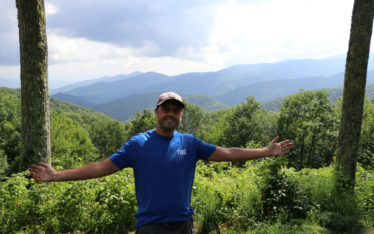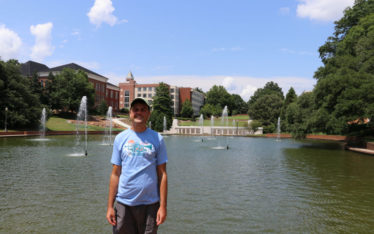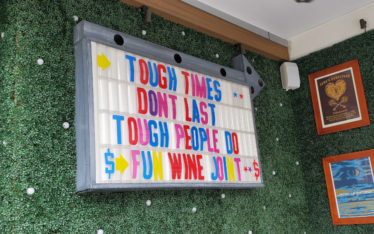For those not accustomed to taking a car ferry, especially on a large ocean going vessel it’s a pretty neat process. Julie and I woke up from our campsite in North Sydney, NS that was only about a 15-minute drive to the ferry terminal. With the ferry leaving at 11:45am we had to be there by 9:45 at the latest. Knowing that we woke up a little earlier than normal ate breakfast, packed up and we were off arriving just after 930. The check in process for the Marine Atlantic Newfoundland ferries goes like this. You drive along the highway getting off at the exit for Marine Atlantic. Next up is a tollbooth type structure. You check in there and receive boarding passes. From there you are told which lane to get in and wait. There are 15 lanes and you get put in one with other vehicles of your size (cars & trucks, RV’s, buses or commercial semi-trucks). From there you can either wait in your car or go into the ferry terminal where there is a small restaurant, gift shop, tourist info area and waiting area. We drove Bubbles to our assigned lane, parked and went into the terminal. About an hour prior to departure an announcement comes over the intercom to go back to your vehicles. From there a worker comes to your car, scans your tickets and your set off to follow the vehicle in front of you into the boat. Once up the ramp into the hull of the boat your directed to a lane and a worker will tell you when to stop and park your car. From there you grab whatever you will want for the next 7 hours and head upstairs. There are staterooms if you have booked one but for most people (including us) you would head to floor 7 where there is a restaurant/bar/lounge area as well as 2 movie lounge areas. So for the 7-hour ride to Port aux Basque, NL we had lunch, worked on our budget as well as worked on our blog and picturing editing and read some books. There is not much to look at out the windows as you’re in the middle of the Atlantic so you do need something to keep you busy. Once the boat reached Port Aux Basque you are told to return to your vehicle then are guided out by a worker, through the port and right back onto a highway. It was an all day process but we did it! We were finally in Canada’s most eastern as well as their most unique English-speaking province!
In most parts of rural Canada there is only one road to drive on and for the most part Newfoundland is no different. The only road that crosses the province from east to west is the Trans Canada Highway or Route 1. We arrived and were able to exit the ferry from Port aux Basque around 645pm (Side Note: Newfoundland is in its own time zone which is 30 minutes ahead of the other Maritime provinces which are in Atlantic time). We drove about 30 minutes north to our campsite for the night. On that short drive we were already blown away by how much Newfoundland was different than Cape Breton and the rest of Nova Scotia. The landscape around us initially was rocky and barren but transitioned quickly to huge mountains with pine trees as far as we could see. Once we arrived at our campsite and made dinner we came up with a plan of what to do in the province. The first few days were going to be spent going north to Gros Morne National Park then to the northern tip of the western peninsula to visit L’Anse aux Meadows which is where Vikings first landed in North America. We would then go east eventually ending up in the largest city and capital St. John’s.
We woke up the next morning eager to explore the province. We started our 6 hour drive north, stopping in Corner Brook for supplies before continuing on to Gros Morne. Gros Morne is not only beautiful due to it being located among mountains situated next to the ocean but also it is one of the only places on earth where you can see peridotite which is rock from the earths mantle which was forced to the surface millions of years ago. The landscape around the area of the park where the peridotite rock is located transitions from lush pine forests to a rocky almost desert like atmosphere. It’s really pretty neat. We spent the night at the park and the next morning woke up to our first sunny day in the province. We explored Gros Morne a bit more taking advantage of the sunny weather to take some great pictures of the mountains and ocean before heading out. Next up we were driving to the very tip of the western peninsula, a 5 hour drive from the more centrally located Gros Morne. This drive was beautiful. It took you through small fishing villages and different landscapes. Small and large fishing houses dotted to landscape with mountains of lobster pots next to the road in spots.
As we started to get close to the tip of the peninsula the temperature started to drop and not only did we start to see snow just up in the mountains but on the ground around us too. It was around 40 degrees but in some spots there were still feet of snow on the ground where drifts had collected over the winter. Not only was snow that was still around on the ground a surprise but as we came around a bend to a bay we started to see icebergs. At first it was just one or two but the further north we went entire bays were covered in small icebergs (later we would come to find out these small icebergs were referred to as “bergy bits”. We stopped in a few places taking numerous pictures as neither of us had ever seen an iceberg before.
We kept on driving north and eventually reached our destination at the tip of the peninsula of L’Anse aux Meadows. We thought it was a little funny that the Vikings called this place “Vineland” in an effort to bring new people to this location. Looking around it just looked like a rocky outpost not capable of producing much at all on the land other than low-lying trees and some shrubs. It was extremely neat to be there though. The national park service has done an excellent job in recreating sod homes just like the Viking had built over 1000 years ago. Inside the recreated structures were actors in period clothing explaining what their role in the village was as well as asking any other questions that you might have on what the Vikings did in the area. You could also walk around the outlines of the actual structures that the archeologists excavated in the 1960’s. Just standing in a spot where the first Europeans stood over 1000 years ago made it a very special place. Before leaving we climbed to the top of a hill where some Viking statues were and looked out into the bay that was just covered from side to side in icebergs. It really did look like a place where Nordic Vikings would live.
That night we spent the night in St. Anthony’s, which was the largest town on the tip of the peninsula. It was a bit rainy (and with drifts of snow still on the ground). We booked a place in town and went out to eat. During dinner we started to plan out the rest of our trip on the island.
Next up….13 hours on the road to St. John’s.



That was a wonderfully written piece. It felt like I was right there with you. Can you insert pictures on your blogs?
Just having internet issues, will try to asap